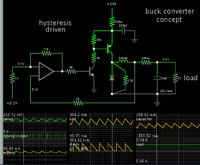pc9460
Junior Member level 3

Hi,
We give informations on partnumbers. Look at at least one of the datasheets found via the linear selection guide.
Please read it - or at least look at the pictures - then you will find out, that there is no need for external drivers nor external FETs. All inside.
As i wrote: 8 parts in total.
How can I say it more clearly? No need to generate a PWM. PWM controller with regulation loop inside. Constant 5V output voltage.
Klaus
The point me building this smps is that it has to be custom. I can't buy an ic that does the entire buck portion as it wouldn't be custom. Thanks for the input though!


